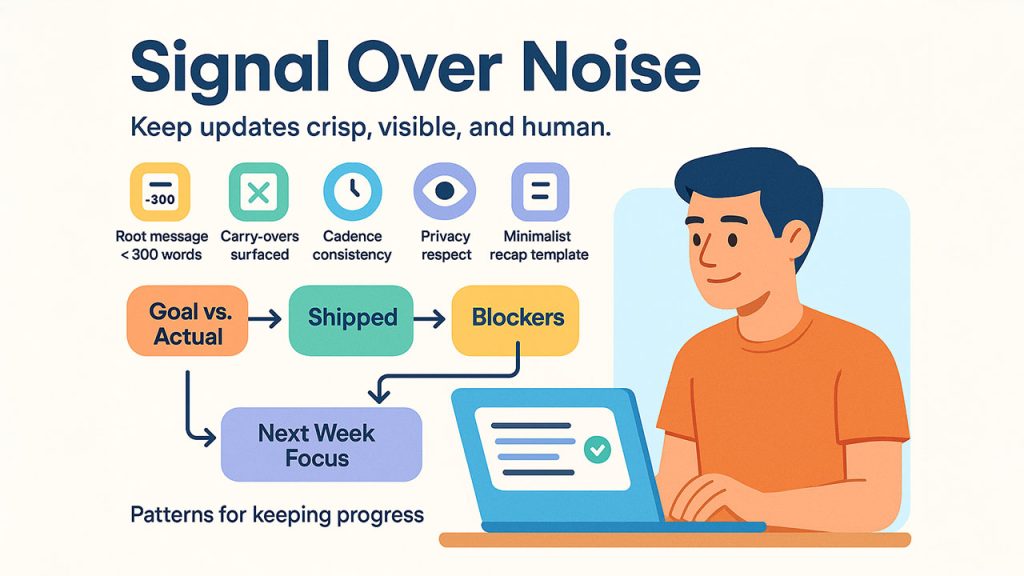If your weekly retro is sixty minutes of sighs for ten minutes of value, you’re not broken; your format is. Teams already talk about where work happens (Slack) and track truth
If your weekly retro is sixty minutes of sighs for ten minutes of value, you’re not broken; your format is. Teams already talk about where work happens (Slack) and track truth in a system (Monday). The trick is to let Slack handle attention and Monday remain on the record, then use a thoughtful Monday and Slack integration to automate the bridge between them.
A good no-meeting retro does three things: 1) reduces carry-over, 2) unblocks work faster, and 3) increases participation without calendar tax. Teams don’t require fewer conversations—they actually need simple and well-organized ones. Google Meet automation can help shorten calls and auto-record summaries for async follow-ups, especially for reviews and standups that are still looking for real-time conversation. Instead of herding everyone into a room, you publish one high-signal Slack digest built from Monday data and then let the conversation play out in a thread. People skim, react, and act, and the system learns.
The Recap Engine (how it actually works)
Think of it as a simple repeatable loop:
Query Monday → Filter → Aggregate → Draft → Post to Slack → (Optional). Write back a “Summary” item in Monday.
No step needs to be fancy. You pull the last 7–14 days of changes from your Monday board(s): status, owner, labels/tags, timeline, dependencies, and one or two numeric fields (story points, ROI, leads, tickets). You filter to what matters (Done / In Progress / Blocked). You group by outcomes (Shipped, In Flight, Blockers, Wins), then draft a short recap that links back to Monday items for depth.
The Slack post is short on purpose. The root message carries the summary; the thread carries details. A human owner reviews the draft in two minutes, tweaks a name or ETA, and hits Post. That’s your human-in-the-loop safety valve, the difference between automation and spam.
Example root post (what “good” looks like):
Sprint 08 Recap Goal: 15 cards, Shipped: 14 (93%)
Shipped: Pricing page A/B (MKT-12), Zendesk macro pack (CS-44), SSO rollout to EU (OPS-31)
In Flight (ETA): Blog launch (Tue), Onboarding wizard (Wed)
Blockers → owner → next step: SDK license wait → @devon → vendor ping Mon 10:00
Wins: +18% sign-up conversion from hero copy test
Next Week Focus: 1) stabilize SSO 2) content refresh 3) roadmap grooming
read / need helpEverything else's full item lists, metrics, and graphs can live in the first threaded reply, ideally posted by the bot, so the thread becomes your living minutes.
Patterns That Keep It Useful (signal, not noise)

Keep the root under 300 words. If you can’t read it on a phone in one breath, it’s too long. Limit to 5–7 bullets total across sections. Put the rest in the thread, grouped and linked.
Make carry-over and blockers impossible to ignore. If an item is carried over more than once or blocked for more than three days, surface it in the root with owner → next step. Public sunlight is a powerful lubricant.
Choose a cadence you’ll actually maintain. Fridays at 4 p.m. local time work for many teams; mid-week (Wed 11 a.m.), a small “stalled >3 days” nudge in the same thread keeps momentum without nagging.
Shape for the team, not the tool.
- Engineering: throughput, bugs closed, “ready to release.”
- Marketing: content shipped, channels with lift, A/B results.
- CS/Ops: SLA hits/misses, top tags, escalations, and mitigations.
Respect privacy and governance. Private boards → private channels. Avoid PII in public recaps. Always link back to Monday items; that’s the ledger.
A minimalist template you can copy:
- Headline: Goal vs. Actual (and %).
- Shipped: 3 bullets with Monday links.
- In Flight (ETA): 2–3 bullets with dates.
- Blockers (owner → next step): 1–2 bullets in plain language.
- Wins: 1–2 outcomes with impact.
- Next Week Focus: top 3 with owners.
- CTA: ✅ read / need help (reactions drive quick triage).
If your recap routinely exceeds those guardrails, it’s not a digest; it’s a report. Keep the key points in the root message and move the full report to the thread.
Adoption & Proof (make it stick)
Treat rollout like a behavior change, not an IT task.
Pilot one team for two weeks. Pick a board, a channel, a schedule, and a human owner. Share a 15–20 minute demo recording: what the digest looks like, where to reply, how to assign themselves from the thread. Pin “How we use this recap” at the top of the channel.
Tune once. After week one, remove one noisy section and add one missing signal. For many teams, that means demoting “In Flight” details to the thread and promoting “Blockers” to the root with clear next steps.
Measure a tiny set of outcomes.
- Time to recap: manual vs. automated (minutes per week saved).
- Carry-over %: items that slip across iterations.
- Blocked >3 days count: the trend line should fall.
- Participation rate: % of team reacting or commenting in the thread.
- Planned vs. Actual: a simple ratio is enough.
You’re not chasing perfect analytics; you’re validating that attention moved to Slack, truth stayed in Monday, and work sped up.
If the stock Monday ↔ Slack automation can’t express your reality in multiple workspaces, custom fields, approvals in Slack that write back to Monday, or strict privacy rules, then bring in a specialist. Fivewalls designs Slack-first, Monday-true recap engines: enriched parsing of Slack threads, auto-mapping to Monday fields and owners, role-aware posting schedules, and clean audit logs. The result is a digest that your team trusts and actually reads.
Final thought
No-meeting retros aren’t about dodging conversations; they’re about shrinking ceremony while keeping the parts that move work: shared visibility, fast unblocking, clear next steps. Let Monday hold the facts. Let Slack carry the story. And let a simple, well-tuned recap engine do the connecting so your team closes more loops with fewer meetings.
Respond to this article with emojis






